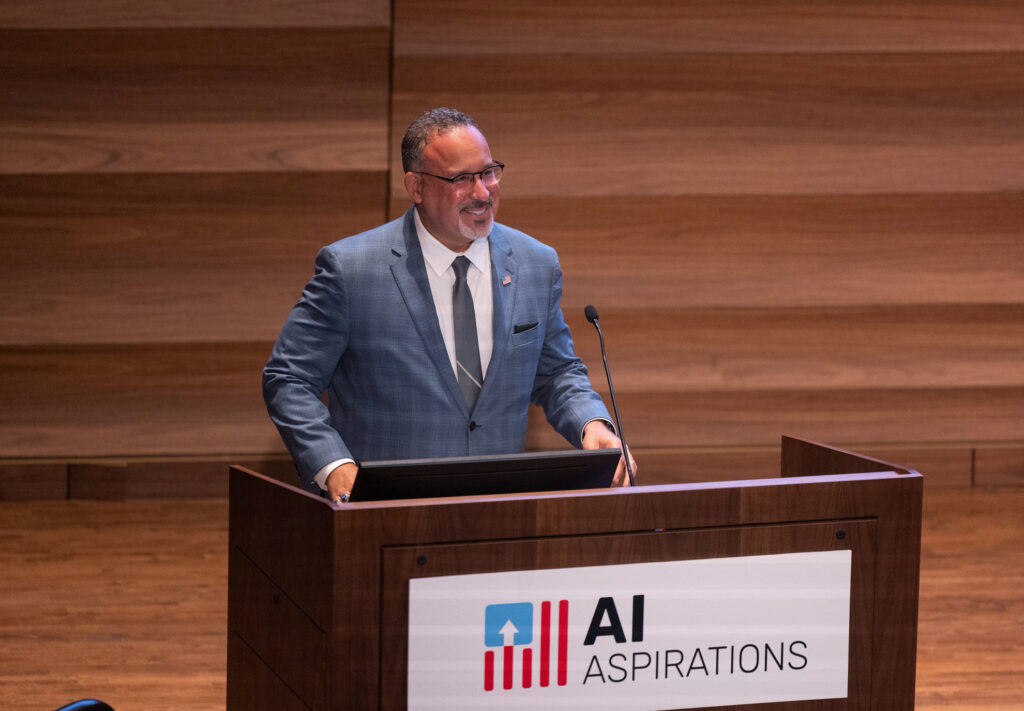How artificial intelligence can transform key U.S. industries
Leaders from across sectors gathered to discuss how AI can be used to solve industry challenges and ways to combat its potential risks to meet future goals
Key Takeaways:
- Industry leaders across various sectors came together at the “AI Aspirations” event at Hopkins Bloomberg Center to discuss the potential opportunities and risks for using AI in each industry.
- From education to the climate change, AI has the potential to solve problems and further advancements in each industry today and in the future, they said.
- Experts also shared how to combat potential challenges and the need for collaboration to achieve these goals.
From advancing health care to improving education, AI has incredible potential to transform the future of key industries throughout the U.S. and around the world. And yet with the all the possibilities for innovation also come concerns about societal risks and safety.
“We all know AI is the defining technology of our generation, and it has incredible potential to make us smarter, faster, and more innovative and accurate,” said Secretary of Commerce Gina Raimondo, one of the speakers at the recent “AI Aspirations” event at the Johns Hopkins University Bloomberg Center. “But I think we can only fully harness that potential by keeping a lid on the danger.”
At the event, leaders from across sectors and industries gathered to explore how our nation can take advantage of AI’s potential, while mitigating its risks, to solve the challenges of today—and the future.
AI, for instance, could help alleviate problems brought on by climate change. Our power grid is currently vulnerable as a result of aging infrastructure, extreme weather, and increased demand, said Evelyn Wang, director of the Advanced Research Projects Agency-Energy (ARPA-E) at the U.S. Department of Energy.
As a result, more than 300 million people are expected to face power shortages this year, according to a recent report by the North American Electric Reliability Corporation. Wang shared how AI can be used to combat these challenges through things such as grid simulations, which allow grid operators to analyze the potential impact of weather events and plan accordingly. AI could improve renewable energy deployment speeds fivefold, with five times greater reliability, making an inconsistent energy source more consistent, Wang said.
Similarly, AI capabilities could alleviate some of the most pressing issues in education. AI could help teachers individualize lesson plans for students to support each child’s unique need, said Nathan Jones, commissioner of the National Center for Special Education Research at the Department of Education. Jones said AI can also help remove some of the burdens teachers face, such as providing personalized tutoring, offloading time-consuming non-essential tasks, and generating high-quality and high-interest readings for students.
“When it comes to AI … education is being disrupted for us,” said U.S. Secretary of Education Miguel Cardona, another expert at the event. “Let’s not waste the opportunity to shape and inform change for the better.”

But Jones and Cardona both emphasized the need for guidance and guardrails around AI in education, such as protecting the data and privacy of students and teachers, and involving educators in every step of the process. The resources would also need to be distributed equitably across all communities, Jones said, to ensure students from all backgrounds have access to AI’s benefits.
“AI gives us the power to transform the lives of students and educators across all of our schools, but it’s not going to happen organically, and it’s not going to happen through the market,” he said. “It’s going to be because there was a concerted national effort to invest in and reach every child in this country—and I think we should be satisfied with nothing short of that goal.”
Amid these exciting possibilities, industry leaders touched on the potential barriers to using AI in each sector. Challenges include accessing and obtaining good data—as some of it is proprietary or doesn’t exist yet—training and testing the AI models in the real world, and changing the minds of those who are skeptical of AI in each industry.
Leaders at the event also emphasized the need for collaboration among all sectors to achieve these AI aspirations, as well as the importance of including voices from often underrepresented populations in these conversations.